Sharlyn J. Lauby's Blog, page 91
October 11, 2019
Use the Right Technology Tool For the Job
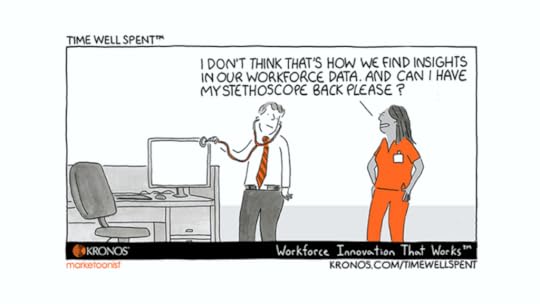
The word “hack” is often used instead of tips.
For example, here’s a blog post on “100
Incredible Life Hacks that Make Life So Much Easier”.
The first one is “Tie a small piece of fabric to your luggage. Saves a lot of
time to check if it’s your bag or not.” I like to think of hacks as discovering
new ways to use common items. For example, when I travel, I always have a small
binder clip with me in case since the curtains won’t close right. Binder
clips are multi-taskers as Alton Brown would say.
But this Time
Well Spent from our
friends at Kronos reminds us that not everything can be
or should be hacked. There are times when there’s one tool for the job and we
need to use it. Or that there are several tools for the job, but some
definitely aren’t it (like a stethoscope).
When purchasing and using technology, understand how to leverage its data. Whenever Mr. Bartender and I purchase technology, we ask questions about how to get the most out of it. We compare our needs as users to what the technology can provide. It’s really important for organizations not to overspend nor underbuy when it comes to their technology needs.
It’s okay to experiment but have a baseline. I find that once I learn a new piece of technology, I’m always asking myself, “I wonder if it will do this? Or maybe that?” It’s perfectly fine to be curious and give these ideas a try. Think of it in terms of the scientific method or an HR Laboratory. But in order to determine if the experiment worked, it’s helpful to have a baseline of data. Preferably, the baseline would be from the recommended way of doing things.
Look for technology “extras” like strategic partnerships and accessories that can create new opportunities. The good news is if you’re looking for ways to hack your technology, chances are that others are too. I believe this can spark innovation. And technology companies might introduce a new product, service, or create a strategic partnership with another company to deliver that “hack” you’re looking for.
Hacks – or tips – can be very helpful and make
our lives a little easier. They can save us from buying something we don’t
need. Or allow us to do something that we’ve wanted to do. We have to be
careful though that the hack provides the proper experience or gives us the
correct result. We can ensure that our hacks are good ones by asking the right
questions and experimenting before making the leap to a new way of doing
things.
The post Use the Right Technology Tool For the Job appeared first on hr bartender.






October 10, 2019
7 Career Lessons Learned from Attending a NASA Social

Over the summer, Mr. Bartender and I attended NASA’s Ascent
Abort flight test. The Ascent Abort flight test was a
simulation designed to ensure that NASA can maintain astronaut safety in case
of an emergency. The test flight was done as part of the preparations for next
year’s Artemis launch.
We’ve lived in Florida a long time and believe
it or not…we’ve never been to a launch! This one was special because we applied
for (and received) special passes as part of NASA’s social media squad. So, we
spent the day touring NASA facilities and learning more about the organization.
While the day was focused on science, it occurred to me that during this day of
fun and education that there were some career lessons to be learned.
Set goals and be patient. It took us a long time to get accepted into the NASA social media squad. We’re talking years to find an event where we both were approved and we both had the time available. If you want something, then you have to be willing to stay focused and be persistent. If you’re not willing to do that, then is it time to ask yourself if this is the right goal?Do work that you enjoy. We had the chance to hear from a couple of NASA engineers working on the project and they talked about how they got their jobs. One explained that he entered a robotics competition being hosted by NASA. His entry got him an internship, which ultimately got him the job. It goes to show you that you can play games, have fun, and still make a living. Some great career lessons!There are many career paths. When we think about STEM (science, technology, engineering, and math), keep in mind that there are lots of different kinds of science. The engineers we spoke with (see #2) talked about the value of other sciences like biology, chemistry, physics, geology, etc. The point being that organizations like NASA look for candidates in all of these areas. Diversity matters. Adding to point #3 above about different sciences, NASA shared on several occasions how diversity and inclusion have helped them reach their goals. While the movie “Hidden Figures” doesn’t always paint NASA in that light, maybe they’ve had their own career lessons from the past and embraced how different people from different backgrounds can unite for the love of space. Be curious. Speaking of rallying behind the love of space, that was certainly the case with our social media squad. We were quite a diverse group from different parts of the country, different occupations, different ages/races/genders/etc. What made us a group was our mutual curiosity about space. I equate this to all of the innovation we see today in technology. We might not have all the answers, but we’re curious. Learn how to problem-solve. There’s a famous scene in the movie Apollo 13 where the engineers at NASA are challenged to put a square peg in a round hole to save the astronauts in space. I love the way that the lead engineer sets up the scene in terms of the goal and what the crew has available to them to fix the problem. We all face challenges and have limited resources. The question becomes how do we still get things done?Always practice safety and security. Finally, I saved this one for last on purpose. Always, always, always be safe. NASA did a great job of practicing safety and security – from our pre-arrival background checks (yes, we had to do them) to on-site badges, etc. It might be tempting to cut corners at times, but we need to make sure that we’re not putting ourselves or others in jeopardy.
We had a wonderful time at NASA headquarters in Central Florida. It was educational and exciting. But it also made me realize the importance of setting goals, working with people who were different from me, and staying curious. Because those are the things that will allow us to go to the next galaxy with our career.
Image captured by Sharlyn Lauby at Kennedy Space Center and yes, that is a real sign.
The post 7 Career Lessons Learned from Attending a NASA Social appeared first on hr bartender.






October 8, 2019
Labor Law Postings: 3 Employee Groups with Unique Posting Requirements #MindTheGap

(Editor’s
Note: Today’s article is brought to you by our friends at
Poster Guard®
Compliance
Protection, a division of HRdirect and the leading labor law poster service
that gets your business up to date with all required federal, state and local
labor law postings, and then keeps it that way — for an entire year. Enjoy the
article!)
A little history
about today’s image. “Mind the Gap” is a warning phrase used to advise
passengers to take caution when crossing the spatial gap between a train door
and station platform. It was first introduced in the 1960’s on the London
Underground. So, my take is the phrase is designed to remind us to maintain safety
in an area where we probably already feel very comfortable.
Today’s topic is
exactly why I wanted to share a little bit of history about “Mind the Gap”. It’s
very easy to dismiss warnings about labor law posters with “Oh, we have all the
right ones.” or “There will be headlines everywhere when our posters need to be
updated.” Not true. While I’m not saying that government agencies are out to
catch businesses that aren’t in compliance, it’s important to realize that in
today’s “signal and noise” world, there’s no guarantee that labor law poster
updates are going to automatically move into the trending topics section of
your favorite social media platform.
So, in the first article
of a three-part series, I want to talk about how labor law posters have some
unique requirements for certain employee groups.
Group
#1: Postings for Job Applicants
Gap #1: Don’t Assume Labor Law Postings are Only for Employees
We have a
tendency to think of labor law postings as being just for our employees. Truth
is, four of the six mandatory federal postings apply to applicants as
well. There are also state and local
requirements. Physical postings must be
displayed for applicants that come into your office for pre-employment interviews,
testing or any part of the application process. By law, applicants must be able
to view these federal postings in your business:
Equal Employment Opportunity
Commission (EEOC)Family and Medical Leave Act (FMLA)Employee Polygraph Protection Act
(EPPA)USERRA – Uniformed Services Employment
and Reemployment Rights Act (also known as USERRA and recommended as a best
practice because the law applies to applicants)
And if your
organization accepts online applications, there needs to be a way for
applicants to view them there too. In an article on the ApplicantStack blog, 98% of Fortune 500 Companies are
using applicant tracking systems (ATS), 66% of large companies use ATS, and 35%
of small companies. As more organizations look to technology to help them
automate their processes, they need to think about compliance.
Group
#2: Spanish Language Postings
Gap #2: Don’t Assume Spanish Language Postings Only Apply When You Have Spanish Speaking Employees
As of July 1,
2017, the U.S. Census reports that the Hispanic population of the
United States was 58.9 million, making people of Hispanic origin the nation’s
largest ethnic or racial minority. There are ten states with a population of
more than one million Hispanic residents: AZ, CA, CO, FL, GA, IL, NJ, NM, NY,
and TX.
Twenty-one (21)
states and territories are required by law to have certain labor law postings
in English and Spanish, regardless of the composition of the workforce. Additional
laws apply if you have locations with a significant number of Spanish-speaking
employees who are not proficient in English. Those locations must post certain
federal labor law postings in both English and Spanish. Though not mandatory,
it is in your best interest to display all of the state posters in English and
Spanish in those locations as well.
Organizations
cannot make the assumption that, if they do not have Spanish-speaking workers,
they don’t need Spanish language posters. They also cannot assume if they have
bilingual employees that they don’t need Spanish language labor law postings
just because those employees also speak English.
Group
#3: Postings for Remote Workers
Gap #3: Don’t Assume that Labor Law Postings are Only for Office Environments
According to the
small business funding site Fundera, over 3.7 million employees work from
home at least half of their time. That’s roughly 3% of the entire U.S.
workforce. If you’re thinking that doesn’t seem like a lot, keep in mind this
represents a 115% increase in telecommuting since 2005.
Working from home
is popular for several reasons. It reduces the costs for commercial office
space, decreases our carbon footprint, and makes employees more productive. In
an article from the Society for Human Resource Management (SHRM), telecommuting employees are more
productive and save companies billions.
Organizations
with a remote workforce need to audit their processes to ensure everyone has
access to labor law postings. Some recent U.S. Department of Labor opinion
letters and court cases have determined that electronic notices are a
reasonable alternative for remote works.

Close
the Compliance Gap with Your Labor Law Postings
I’d like to think
that most employers know they need to have labor law postings. But I can also
see organizations forgetting to “mind the gap” where postings are concerned and
forgetting to take the extra caution that needs to take place with applicants,
Spanish language postings, and remote workers.
But the good news
is that organizations don’t have to spend hours researching this information. Our friends at Poster Guard have a
Labor Law Poster Service that will do it for you. Yep, that’s right. Poster Guard
monitors labor law requirements (at the federal, state, and local level) and
lets you know when things change. They also provide you with replacement
posters every time there’s a change FREE of charge!
Frankly, this is
a no brainer for me. As a human resources professional, I have so many other
things I need to spend my time on than researching labor law posters.
Personally, I would much rather have a professional service do what they do
best, which frees up my time to recruit, engage, and retain the best employees.
P.S. Stay tuned
for part two in this series when we talk about how different industries require
different labor law postings. In the meantime, you can test your labor law poster knowledge
with Poster Guard’s Mind the Gap quiz.
The post Labor Law Postings: 3 Employee Groups with Unique Posting Requirements #MindTheGap appeared first on hr bartender.






October 6, 2019
The 9 Faces of HR – Which One Are You
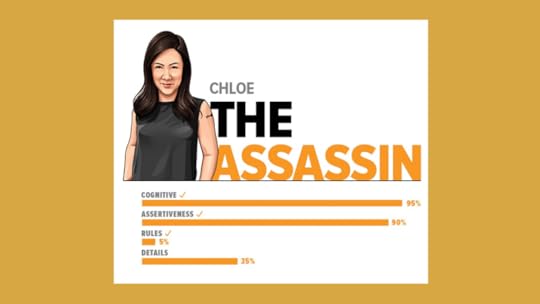
I want to be a bit nostalgic today. The very first article I ever published on HR Bartender was based on something written by Kris Dunn, chief human resources author at Kinetix and founder of the wildly popular blogs The HR Capitalist and Fistful of Talent.
The reason I’m bringing this up is because that very first article talked about our actions speaking louder than words. And all these years later, that old cliché still rings true. As HR professionals, we need to figure out what we want to be known for and demonstrate it with our actions. The good news is we don’t have to figure it out all on our own.
Kris Dunn has written a new book titled “The 9 Faces of HR: A Disruptor’s Guide to Mastering Innovation and Driving Real Change”. The book does a deep dive into career development for human resources professionals. This is something I don’t believe that we spend a lot of time doing because we’re so busy taking care of everyone else in the company. So, I asked Kris if he would share with us his insights and thankfully, he said yes.
Kris, congratulations on the success of your book, “The 9 Faces of HR”. For those people who haven’t picked up a copy yet, tell us why you wrote this book?

[Dunn] Thanks for your interest in ‘The 9 Faces of HR’! I wrote the book because I felt like the world of HR needed a career guidebook. If there’s one thing that’s constant in our current world of work, it’s change. In our desire to help others through environments with massive change, we’ve forgotten to take care of ourselves in HR.
The world’s moving pretty fast these days. I have a lot of examples in my own network of HR pros at all levels being impacted by change. I believe 100% they could have avoided layoffs, built better relationships across their organization and more – if only they were aware of the signals they were sending about change and innovation.
My second goal was to write a book that’s more entertaining than the average HR book. The 9 Faces was a blast to write and hopefully, readers will find it educational and enjoyable.
The “9 Faces” as it’s explained in the book is similar to the traditional 9-box grid, which many HR professionals will be familiar with. But I’m dying to know, how did you come up with the names for the 9 Faces?

[Dunn] Ha – you know how I came up with the names – I just looked around and decided what to call people with very specific worldviews. Most people who read the book automatically recognize the faces, because they’ve seen them all before in the world of HR. Everyone knows the ‘Cop’, the ‘Judge’ and the ‘Assassin’. I might have had to brainstorm a bit more on the others, but I think I found names that automatically give the reader a sense of the person/persona they’re looking at.
You could have done the naming idependent of me and there’s a good chance 3 or 4 of the 9 names are the same. We know these characters well in the world of HR!
I’m always drawn to books like yours because I want to find out “What Face am I?” How would you suggest someone go through that self-discovery process?
[Dunn] There are good instructions in the book for this and it’s pretty easy.
Simply find a behavioral assessment you have access to (preferably with a cognitive component) and go through that assessment. Once you’ve completed that, locate your scores for cognitive, assertiveness, rules orientation, and detail orientation and browse the chapters that detail each of the 9 Faces. Find a profile that matches you and cross reference to make sure you’re at the right career level and presto – you’ve got a hot take regarding which of the 9 Faces you are.
I’m also available to put anyone who buys the book through our house assessment platform and will share the results and give a reading on which face that person is. Just ping me!
The book doesn’t just talk about the “9 Faces”. It provides a playbook for taking ownership for your career development. Once I understand what Face I am, how should I use this book to develop my career goals?
[Dunn] The key is to use your knowledge/self-awareness of your persona to understand your natural state and the signals you put off. Once you understand that and read the book, you’ll understand that in organizations with change (and who doesn’t have change?), every day is a test. People are constantly evaluating you to understand if you’re fast enough, innovative enough, etc. Related – find a way to say ‘yes’ more, even when you want to say ‘no’.
Last question. I know a lot of people will read this book and want to have their teams do the same. But I don’t know that senior leaders always do a good job of socializing books, articles, etc. around the office. What tips would you give to someone who wants to push this message out into their organization?
[Dunn] I’ve had a lot of HR leaders already buy the book for their teams, with the majority of those really running their own book club – whether they know they’re doing it or not. So, buy the book and have your team read 3-4 chapters at a time and then open it up for conversation:
What did they like? What do they call BS on?
Early reports suggest this type of open-ended session is pretty dynamic and also meaningful to get HR team members to consider how they are viewed by client groups.
Of course, the book title and the cover draw HR pros in – as you stated earlier. Everyone wants to know which face they are – as well as which faces the people they love (and hate) in the world of HR are as well.
A HUGE thanks to Kris to sharing his knowledge and experience with us. I know you’re going to want to pick up a copy of his book “The 9 Faces of HR” after reading this interview. You can find it on Amazon.
My big takeaway from “The 9 Faces of HR” book is that, as HR pros, we need to remember that our professional development is important. If we want our organizations to succeed, we need to hire, engage, and retain the best employees. That means having a strong HR function.
The post The 9 Faces of HR – Which One Are You appeared first on hr bartender.






October 4, 2019
5 Key Components Of a Non-Disclosure Agreement
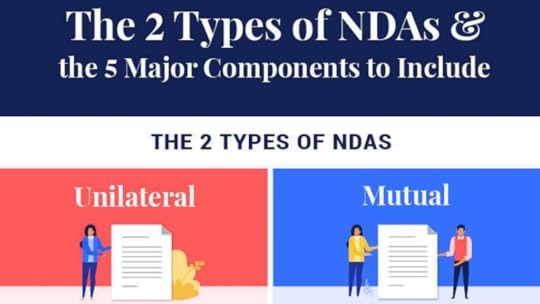
I’ve always worked in highly competitive industries and I’ve seen two schools of thought when it comes to talent.
In the first camp are the companies that say, “Our industry is so competitive that requiring employees to sign a non-disclosure document is an exercise is futility. We will spend all of our time and money with lawyers and in court.” No offense to my attorney friends, but that wasn’t how the company wanted to spend their resources. They focused their energy on being the best and felt that their actions – with employees and customers – would prevail.
The other side was also focused on being the best. But they had a different philosophy. Those companies said, “Our products and services are unique. We’ve worked hard to get to this place in our business. No one should take that away from us.” And they spent the resources to protect their business secrets by asking employees to sign a non-disclosure agreement (aka NDAs).
I ran across this infographic about non-disclosure agreements from Legal Templates and thought it was an easy to read overview of what NDAs are and the key components to look for in an NDA.

The reason I told my tale of two companies at the beginning of this article is because, if you’re an organization using non-disclosure agreements (or considering doing so), it’s important to understand why you’re doing them. And to have a conversation with your legal counsel about how you’re going to enforce them.
And today’s article isn’t just for organizations. If you’re an employee or a job seeker, you need to understand non-disclosure agreements as well. Because when you’re presented with one, 1) you need to read it and 2) you need to decide if you’re going to sign it.
Non-disclosure agreements are serious business. Both parties need to understand the terms of the agreement. The best time to be educated about whether or not you want to engage with one, is before you need to sign one.
The post 5 Key Components Of a Non-Disclosure Agreement appeared first on hr bartender.






October 3, 2019
Celebrate Your Successes Through Micro Victories

I ran across an old Harvard Business Review
article about “The
Power of Small Wins” and it really stuck with me. How
many times do we hear that we’re supposed to focus on BIG – big thinking, big
ideas, big wins, etc.? You get the point. I don’t believe we can forget the
importance of the small things too.
Small activities can lead to big change. I’d
like to think we know that.
But what we might forget to do is congratulate
ourselves for accomplishing those small steps. I know that I’m guilty of this.
I take on a big project and break it down into small steps to make it much more
manageable. Or a set a big goal for myself and establish milestones for
accomplishing the goal. Then I don’t celebrate my success until the big thing
is done. Why not give ourselves a little pat on the back or some form of reward
as we’re accomplishing those smaller milestones?
I recently heard this term called
“micro-victories” also called “micro-wins”. It sounds exactly like what I’m
describing – a way to celebrate a small victory or success. The reason I’m
bringing this up is to encourage us to celebrate our micro-wins at every level.
On a personal level:
When we set goals for ourselves, we need to think about celebrating our
success. Sometimes the goals we set for ourselves are private and we don’t
really make a public statement about them until they’ve been accomplished. Getting
a professional certification is an example. I know
many people who keep their studying on the down-low because they don’t want the
added pressure of having to tell people the outcome of the exam. So, they wait
until they pass and say, “I did it! Yea me!” Which is fine but be sure to
celebrate some successes along the way, like passing a sample quiz or
completing a certification prep course.
On a team level:
Many times, when we work on a team or a project, we have smaller milestones
that must be accomplished along the way. For example, during
a software implementation, there are many steps that must happen
before the project is considered completed. The team should celebrate achieving
those milestones. The project lead or department manager should encourage
employees to celebrate those moments. Not only does it provide a level of
recognition for the team’s hard work to date, but it encourages the team to
stay focused and motivated on the
big, hairy, audacious goal (BHAG).
On an organizational level:
Speaking of BHAGs, companies create big goals for themselves all the time. Those
big goals are made up of several small ones. Organizations should provide
regular status reports to employees where goals are concerned and use those
updates as a way to celebrate what’s been accomplished so far. Especially when
the big goal is something that might take years. Equally important is the need
to celebrate successes when there could be a small shift or adjustment in the
big plan. The last thing companies want is employees to perceive that shift as
a sign of failure (when it’s not) and potentially demotivate the team.
Micro-victories or micro-celebrations are a great way for individuals, teams, and organizations to recognize their successes, stay focused on the big picture, and keep motivation at a high level. Because all of those little steps will be what creates the “next BIG thing” in the organization.
Image captured by Sharlyn Lauby at the 34th Street Graffiti Wall in Gainesville, FL
The post Celebrate Your Successes Through Micro Victories appeared first on hr bartender.






October 1, 2019
Strategic HR Management: 4 Activities That Help Reduce Turnover
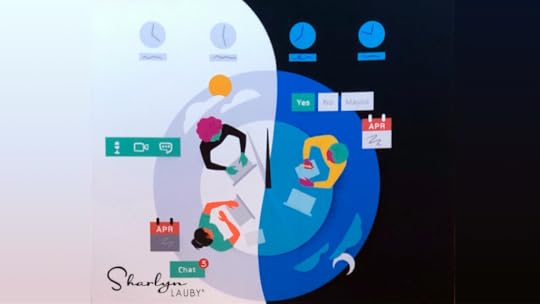
(Editor’s Note: Today’s article is brought to you by
Victoria University Business School
, located in Australia. Victoria
University’s online master’s in business administration program (MBA) was
awarded a tier-one rating in CEO Magazine’s 2019 Global Rankings. Congrats to
them! Enjoy the article!)
Today I want to talk about a subject near and dear to me. I want
to talk about us. Meaning I want to talk about human resources. HR managers are
incredibly important to a business’ success. They help recruit, engage,
upskill, and retain employees. They are an integral component to the growth of
a business in a constantly evolving digital landscape.
As such, human resources professionals need to be lifelong
learners. The strategic HR management principles and practices we learned years
ago, might be less than strategic today. And without a modern strategic HR
management team that is focused on adaptive and flexible employee development,
businesses are at risk of losing employees. According to an article from the
Society for Human Resource Management (SHRM), those annual
turnover costs could increase to $680 billion by 2020.
4 Strategic HR Management Activities That Need Our Focus
So, what strategic HR practices can we focus on to help the
organization achieve its goals? Here are four areas where keeping our knowledge
and skills current will not only help to retain employees but assist in building
a strong company culture to drive success on a local and global scale.
1. RECRUITING: HR facilitates the process of hiring the right people.
One clear area where HR managers have a significant impact on a
business’ global success is through the hiring process. Investing time into developing
a recruiting strategy and not rushing through the process helps the
organization make better hiring decisions.
We can practice strategic HR management by clearly outlining the company’s
expectations, both in a general business as well as a role-specific sense.
Clear and consistent recruitment marketing messages will yield the most
suitably qualified candidates. During the interview, this helps the hiring
manager focus on the job requirements and whether the candidate has the right
practical skills that can help their business succeed on a global scale.
Not only do technical capabilities play a part in selecting the right hire, but soft skills do as well. In fact, studies from Robert Half showed 87% of business leaders found that their most successful hires had values, beliefs, and a general business outlook that aligned with the business.
2. DEVELOPMENT: HR creates formal and informal learning opportunities.
Learning and professional development opportunities are a key way
that HR managers play a role in business performance. Training and development activities
also help the business ensure that they have the relevant skills to compete in
today’s global economy (see number one).
Technology and other innovations have redefined work. As such, we
can practice strategic HR management by ensuring that continual soft skills and
technical skills training and development are available for all employees. By
developing evolving knowledge and skills, HR can help provide employees with
continued growth and a career path from their current position. This has a
direct impact on both employee engagement and turnover. According to a report
from Mercer, 78%
of employees said they would remain longer with their employer if a long career
path was visible in their current workplace.
3. COMPLIANCE: HR ensures that the company maintains compliance with employment laws.
Regardless of where your organization is located, we’re truly a
global economy. Especially with the latest advances in technology. We have the
ability to interact with people and businesses all over the world.
While labor laws differ vastly from country to country, most
countries have strict laws in the area of employment (specifically in terms of
recruitment, immigration, discrimination, terminations, employment contracts,
etc.) We can practice strategic HR management by ensuring compliance in this
area. In addition, HR needs to know when to seek outside counsel, possibly in
the case of the organization merging or acquiring a new entity. Or hiring
employees in another country.
Non-compliance of employment law can have a severe impact, not
just in terms of financial penalties, but also brand and reputational damage.
HR should make compliance a priority to avoid any potential legal issues,
minimize organizational exposure, and any liability that can come from
allegations of employee mistreatment.
4. QUALITY: HR is responsible for effectively and efficiently managing their role.
I’m not sure we talk about this aspect of strategic HR management
nearly enough. As human resources professionals, we have a department and
function to run and we’re expected to run it well. This means managing costs
and quality control.
We can practice strategic HR management by balancing short-term business needs with long-term value. It could involve evaluating employee compensation packages and relevant benefits, along with any programs that may help with recruitment and retention. On the cost-control side, HR could partner with operational managers to develop cross-functional teams that would maximize employee performance while minimizing the cost of bringing in new staff (see number two).
Quality control also is a big component of our role. We must lead
the way with functional management skills that ensure the successful delivery
of business objectives. HR is responsible for implementing systems that will
work for the betterment of the organization.
Strategic HR Management Doesn’t Happen
Overnight
The business world is constantly changing, and we need to be able to change along with it. Because talent is a business differentiator, strategic HR management is just one of the functional, analytical, and financial skills demanded of today’s business leaders.
Whether you’re a business leader or human resources professional, it’s important to grow these skills. One way you can do that is by studying for an MBA. It would allow you to grow your skills and provide you with the foundation to stay current in today’s evolving work landscape.
Image captured by Sharlyn Lauby while exploring the streets of Orlando, FL
The post Strategic HR Management: 4 Activities That Help Reduce Turnover appeared first on hr bartender.






September 29, 2019
Why Is Inequality Low On the HR List of Priorities

I understand that surveys and polls aren’t
always indicative of everyone. But surveys and polls do provide some frame of
reference. So, I don’t know that they should be ignored. Which is why I wanted
to share this one from the Society for Human Resource Management (SHRM) and
Globalization Partners.
The survey reported that the
greatest challenges for global teams included collaborating and scheduling work
across different time zones (49%). But rated last
was unfairness or inequality among global teams (7%). I’d like to think that
you’re saying the same thing I am, “Why is inequality so low on HR’s list of
priorities?” Seriously, why? We know that creating diverse and inclusionary
workforces benefit employees and the business.
Organizations that are trying to create
award-winning cultures so they can attract and retain the best talent need to
have diverse and inclusionary workplaces. I wrote a series a couple of years
ago about building inclusionary cultures.
Defining
Diversity and Inclusion in Today’s Business Climate
Diversity and inclusion are an important part
of employee engagement. Company culture centers on a diverse workforce. And
that drives strong engagement.
Using
Trust and Emotional Intelligence to Establish Your Cultural Identity
Successful recruiting and retention relies on
a company’s cultural identity. It’s a key part of the employment brand. And
it’s built on respect and trust.
Using
Leadership to Establish Cultural Identity
The speed of change has companies scrambling
to keep up. Leadership is key. It helps drive cultural identity through
diversity and inclusion initiatives.
Implementing
an Inclusive Culture
An inclusive culture can offer a competitive
advantage. Diversity training programs are a great start. But leadership needs
to be the champion of diversity.
I’d like to believe that if human resources –
along with the rest of the organization – makes equality and fairness a
priority, then challenges such as collaborating and scheduling across time
zones get easier. I also realize that, in practice, this is much easier said
than done. I’m not implying that we can simply snap our fingers and create
fairness and equality. It takes time. It takes trust. Most of all, it takes
making it a priority.
I certainly don’t have all the answers about inequality here. But this survey does make me wonder if we’re focused on symptoms.
Ever since I read about this survey, it’s made me think about organizational priorities. Are companies truly focused on creating diverse and inclusionary workplaces? If so, is it a priority to have a workforce that feels employees are treated both fair and equal? It really should be.
Image captured by Sharlyn Lauby at the HR Technology Conference in Las Vegas, NV
The post Why Is Inequality Low On the HR List of Priorities appeared first on hr bartender.






September 27, 2019
Unlimited Time Off Programs: Don’t Force Employees to Lie About Their Whereabouts
(Editor’s Note: Today’s article is brought to you by
our friends at Kronos
, a leading
provider of workforce management and human capital management cloud solutions.
Kronos recently announced that, in less than a month’s span, it was named to
four
separate best workplaces lists by Great Place to Work
in Canada,
India, Mexico, and the United Kingdom. Many congratulations to them! Enjoy the
article.)
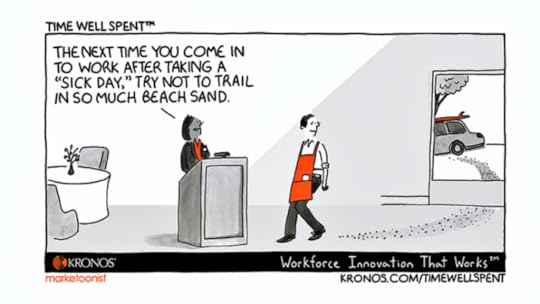
As summer is coming to an end, I’m reminded that one of the
best workplace trends to happen in business today is unlimited time off
programs. Not because we can take a lot of time off, although that can be nice.
It’s because we don’t need to lie about where we are.
Today’s Time
Well Spent from our friends at Kronos
took me back to a time when, if we wanted to enjoy a beach day, we would
suddenly come down with some sort of illness (cough. cough.). Of course, that
illness is the 24-hour type and it’s not one where we usually need to visit a
doctor and get some sort of note. You know what I’m talking about.
With unlimited time off programs, when we want to get in our
last beach day before pumpkin spice season, we simply work it into our
schedule. We coordinate our plans with colleagues and the boss. And we take the
day off guilt-free.
Unlimited time off programs allow employees to be honest about their time-off request. A founding principle in positive workplace cultures is trust. For employee engagement to happen, it requires trust. If we want to create and maintain trust in the workplace, then we can’t design employee programs that require a lie for employees to use them.
When employees can plan, their productivity increases. One of the biggest challenges when employees call off at the last minute is getting the work done. Everyone has to juggle schedules, and something always gets pushed to the side. Unlimited time off programs allow employees to have more control over their schedule, which means they can plan their work in advance.
Managers don’t want to confront employees about this type of stuff. Don’t get me wrong, managers know that part of their job is to address behavioral issues. And they will do that when they need to. But managers also want to be cool. They don’t like being placed in a position where they have to nag employees about every little thing.
If you’re thinking to yourself that unlimited time off programs are a recipe for workplace anarchy, check out the article I wrote last year about how Kronos implemented an unlimited time off program and its results. Employees are using the program responsibly and the company is able to redirect the savings toward other benefit programs that employees have been asking for. That’s what is called a win-win.
Organizations are always focused on performance. We want to
create programs that allow employees to perform at a high level. This doesn’t
mean they can’t take a day (or two) off. It means letting them decide when to
take those days off and holding them accountable for results.
The post Unlimited Time Off Programs: Don’t Force Employees to Lie About Their Whereabouts appeared first on hr bartender.






September 26, 2019
How to Plan for an Organizational Emergency
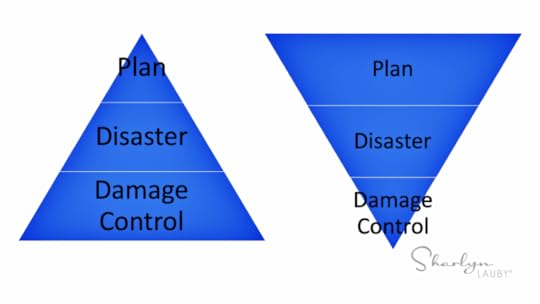
Whether you’re a freelancer or a large
multinational organization, it’s important to have an emergency plan. It would
be wonderful to say that we don’t need to plan because nothing bad is going to
ever happen, but that’s just not very realistic.
No matter what type of business you operate,
you’re going to occasionally have to deal with an emergency. It could be a
natural disaster. Or maybe an accident. Possibly a scandal. Waiting until
something unexpected occurs to put a plan in place doesn’t make sense and could
actually cost the business more than the emergency created.
At WordCamp Orlando, one of the speakers gave
us a good outline for an emergency response plan. They used it in the context
of social media damage control, but I think the principles apply to any type of
emergency.
Plan! I love the pyramid image above to show the relationship between planning and response. A small amount of planning equates to a large amount of damage control. Want to reduce your exposure? Plan more. Detect.
This reminds me of my “seeing the dirt” story. Employees at every level of the
organization need to look for organizational vulnerabilities and report
suspicious or detrimental activity for investigation.Verify.
When an incident occurs, it’s important to verify what happened. In today’s
24-hour news cycle, it’s
easy to get caught up in rumors and speculation.
Take a moment to verify what took place. This doesn’t have to be a full-blown
investigation but do make sure that what people say is going on…is really going
on.Response.
Identify
in advance who the organization’s subject matter experts are.
When an emergency happens, call in the specialists. They should be prepared to
assist.Investigate.
This step works in concert with #3 Verify. The verify step is to confirm
there’s an emergency. In the investigation step, the organization needs to get
details – who was involved, what happened to cause the incident, where did it
take place, when did it happen, how did it happen, and finally why is it
happening.Communicate.
I cannot emphasize enough the value of giving the company’s spokespeople media
skills training. When an emergency strikes, the
community will want some sort of response. In addition, employees will want to
know what’s going on. Being able to communicate effectively – internally and
externally – is essential.Remediate.
Once the emergency has subsided, the
organization should conduct a debrief. Ask two
questions: A) What went well? And don’t say nothing. There will be things the
company does well. Even during a disaster. B) What could we do differently or
better next time? Please note I didn’t say “wrong” because….Review.
And update the plan accordingly. In the last bullet #7 Remediate, I mentioned
doing things differently next time. It’s possible that the company didn’t do
anything wrong. You followed your plan to perfection. But that doesn’t mean you
won’t want to make your plan stronger for the next time. Because chances are…
There will be a next time.
Emergency and disaster planning can help us
understand our organization. They can help employees prepare for the
unexpected. And they can make our operations stronger. The time and resources
we spend planning will help us at a future date. Make the investment. Your
employees and your business will thank you for it.
The post How to Plan for an Organizational Emergency appeared first on hr bartender.






Sharlyn J. Lauby's Blog
- Sharlyn J. Lauby's profile
- 10 followers



